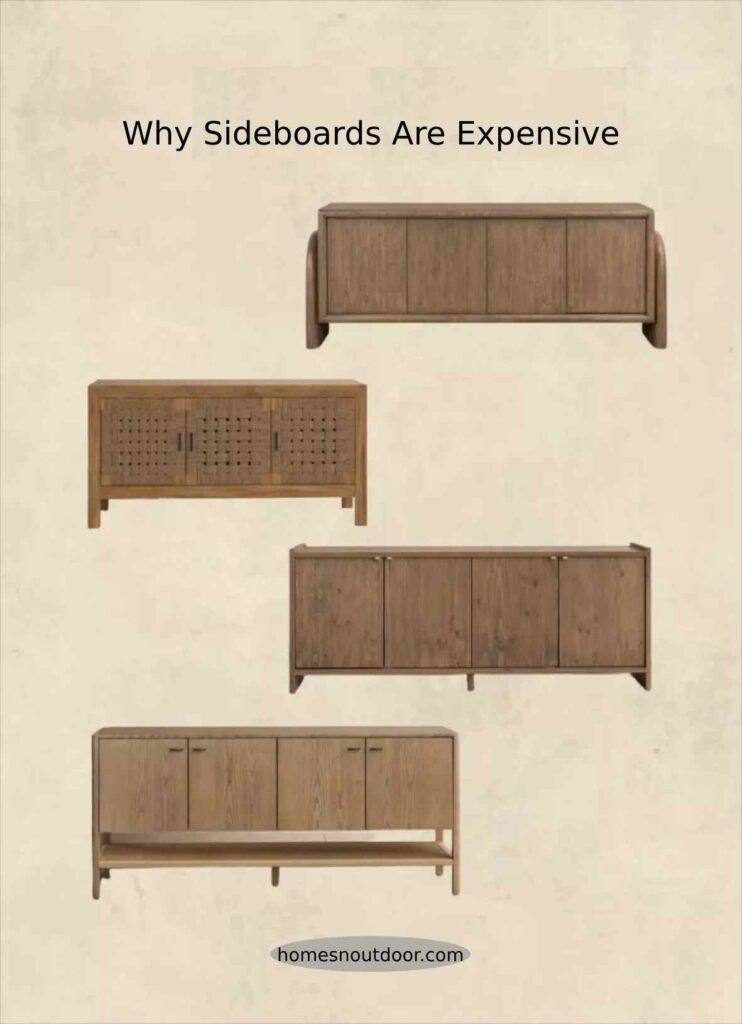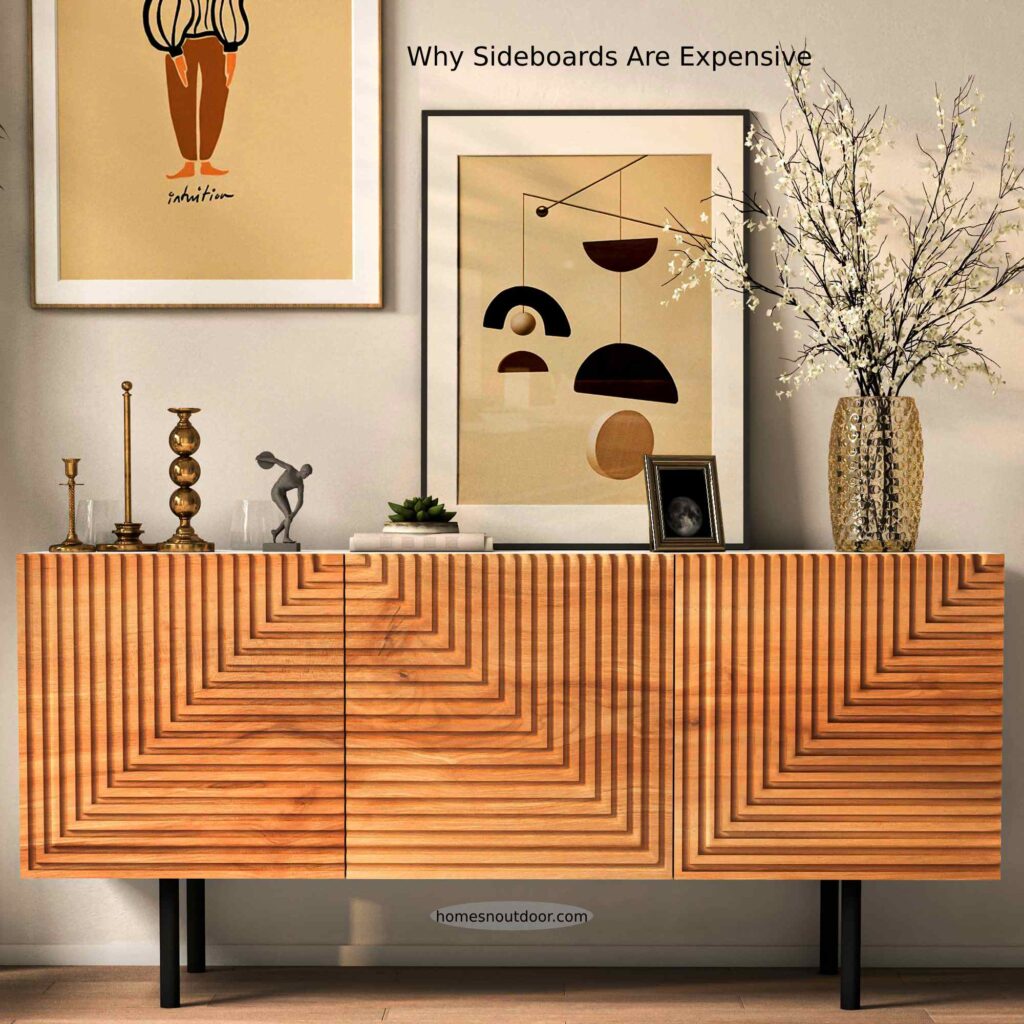Sideboards are expensive due to the high-quality materials and craftsmanship involved. Skilled labor, intricate designs, and durability also contribute to the price.
Sideboards, often seen as a luxurious addition to dining rooms and living spaces, command a high price tag. Their construction typically involves premium wood, such as oak or mahogany, and may include expensive veneers or inlays. These pieces are not just furniture but also a form of art, showcasing the expertise of the carpenters and designers behind them.
The durability and the aesthetic appeal of a well-crafted sideboard make it a centerpiece of a room, speaking volumes about the owner’s taste. As functional as they are stylish, sideboards offer ample storage and display space, resulting in a versatile investment for any discerning homeowner. The combination of utility, artistry, and the use of upscale resources solidifies the sideboard as a valuable furnishing worth its cost.
Understanding Sideboards: A Brief Introduction
Sideboards serve as a multifunctional piece of furniture that transcends mere storeroom utility. Initially crafted to aid in the display and serving of food, these furnishings have garnered appreciation for their decorative and functional versatility. Originating from the simplistic buffets of the 18th century, sideboards have evolved to embody various styles and purposes—ranging from traditional dining room accoutrements to modern statement pieces adorning living spaces.
Today’s sideboards are often reflective of craftsmanship and design-epoch influence. Offering an array of types, such as the antique credenza, the minimalistic Scandinavian design, and the rustic farmhouse appeal, sideboards address diverse interior décor preferences. Typically employed for storing dinnerware, cutlery, linens, or as a platform for decorative objects, they impart both aesthetics and functionality within the domestic setting.
| Sideboard Type | Common Uses |
|---|---|
| Credenza | Office storage, dining room accoutrement |
| Scandinavian Design | Minimalistic décor, modern homes |
| Farmhouse Style | Rustic charm, kitchen storage |


The Craftsmanship Behind Sideboards
The impeccable craftsmanship that goes into creating a sideboard is reflected in the materials chosen. Quality woods such as oak, mahogany, and walnut are often used for their durability and the luxurious finish they offer. High-end fittings like solid brass handles and reinforced hinges also contribute to the overall cost. Each of these premium components ensures a combination of aesthetic appeal and long-term functionality.
Fine furniture making is an art form, requiring a significant investment of time and expertise. The detailed work includes precise joinery, intricate carving, and the meticulous finishing that sideboards necessitate. This level of dedication to the creation process commands a higher price point due to the intensive labor and the specialty skills that are involved.
Custom designs elevate the value of sideboards even further. Tailored to fit individual tastes and spaces, personalized furniture becomes unique to the owner. The customization process adds complexity and requires additional planning, design revisions, and sometimes even the creation of exclusive tools or molds – all of which justify the premium price.
Economic Factors Contributing To Sideboard Pricing
The manufacturing process of sideboards greatly influences their cost. Handmade sideboards often incur higher expenses due to the meticulous labor and unique craftsmanship involved, whereas factory-made pieces benefit from mass production efficiencies. The industry’s tilt towards personalized and bespoke pieces has further solidified the standing of handmade furniture as a costly affair.
Luxurious furniture pieces, like premium sideboards, see increased market demand among consumers looking for exclusivity and status symbols. This surge in desirability can lead to higher price points, as manufacturers aim to cater to a market willing to invest in such luxury items.
Viewing sideboards as a long-term investment, buyers acknowledge their longevity and durability. Quality materials and construction mean these pieces can withstand years of use, justifying their initial expense. The idea of investing in a durable piece of furniture resonates with many purchasers, which plays a role in the premium pricing of high-end sideboards.
Comparing Sideboards With Other Furniture
Sideboards offer a unique blend of functional complexity and aesthetic appeal, setting them apart from other furniture pieces. A typical sideboard integrates a myriad of storage solutions, from drawers and cabinets to shelves, all designed to cater to diverse organizational needs. Craftsmanship in sideboards is thus often more intricate, factoring into their higher price tag.
As statement pieces, sideboards elevate interiors, contributing significantly to room’s design narrative. Their surfaces provide a stage for decorative objects, while their structure embodies a sense of sophistication and style. This duality of purpose – practical storage and decorative appeal – intensifies their value in home design.
Concerning space efficiency, sideboards shine in their ability to offer substantial storage without overwhelming room space. Particularly for homes with limited square footage, a sideboard delivers large furniture utility while maintaining a harmonious spatial balance. This practical dimension of space management often justifies the investment in a high-quality sideboard.
Making An Informed Purchase: What To Consider
Sideboards often come with a hefty price tag, reflecting their versatility and functional value in a home setting. The cost you pay is indicative of the quality of materials, the craftsmanship involved, and the design complexity. Solid woods like oak or walnut contribute to a higher price point due to their durability and aesthetic appeal. Additionally, units featuring intricate designs or hand-crafted details often justify a premium, as they are the result of skilled labor and significant time investment.
To ensure you’re investing in a quality sideboard, inspect the joinery techniques—dovetail or mortise-and-tenon joints, which are indicators of a well-constructed piece. The presence of smooth gliding drawers and sturdy hardware signals attention to detail and additional value.
Maintaining your sideboard is crucial for long-term enjoyment. Regular dusting, immediately cleaning spills, and avoiding direct sunlight or extreme temperatures can protect your sideboard and sustain its beauty and functionality over time. Proper care ensures that your investment not only retains value but may even increase in worth as it becomes a cherished piece for future generations.




Frequently Asked Questions For Why Sideboards Are Expensive
Why Are Sideboards Considered A Luxury Item?
Sideboards are often seen as luxury items due to their intricate designs and the high-quality materials used in their construction. They can be handcrafted by skilled artisans, which adds to the cost. Plus, their multifunctional uses in homes for storage and as statement pieces justify their premium pricing.
What Makes Sideboards More Expensive Than Other Furniture?
The cost of sideboards is typically higher than other furniture due to several factors including the quality of wood, the craftsmanship involved, and the complexity of the design. They often feature detailed joinery and may include additional elements like marble tops or fine hardware, which contribute to the higher price tag.
How Does The Design Affect The Price Of Sideboards?
The design of a sideboard can greatly impact its price, as pieces featuring intricate patterns or unique shapes require more time and skill to create. Designer sideboards or those with bespoke features can command higher prices due to their one-of-a-kind nature and the level of detail involved in their construction.
Can The Size Of A Sideboard Influence Its Cost?
Yes, the size of a sideboard can influence its cost. Larger sideboards use more materials and may require more labor to construct, which can increase the price. Additionally, bigger sideboards might have more elaborate designs and additional storage features that also contribute to a higher cost.
Conclusion
Understanding the high cost of sideboards is crucial for any discerning furniture buyer. Quality materials, intricate designs, and skilled craftsmanship drive the price higher. As an investment in both function and style, choosing the right sideboard ensures both aesthetic appeal and lasting durability.
Remember, the value extends beyond the price tag, enriching your space for years to come.

